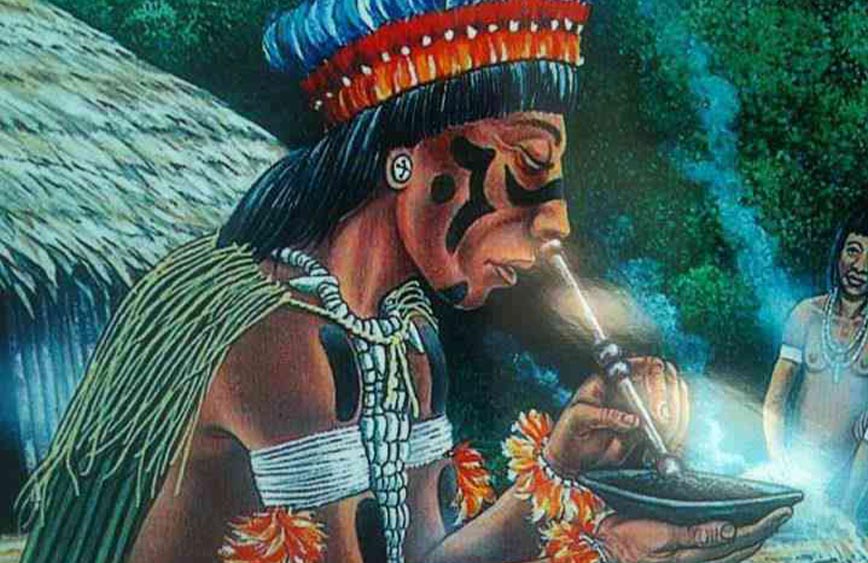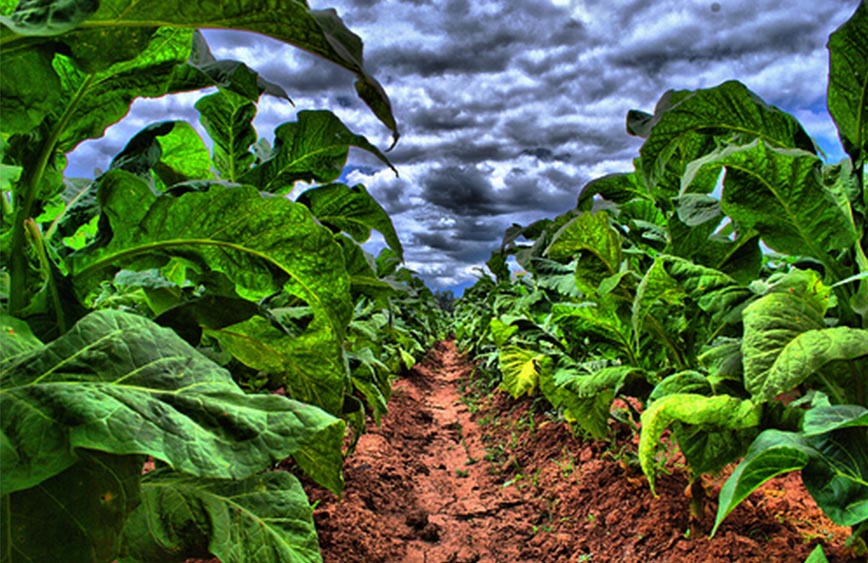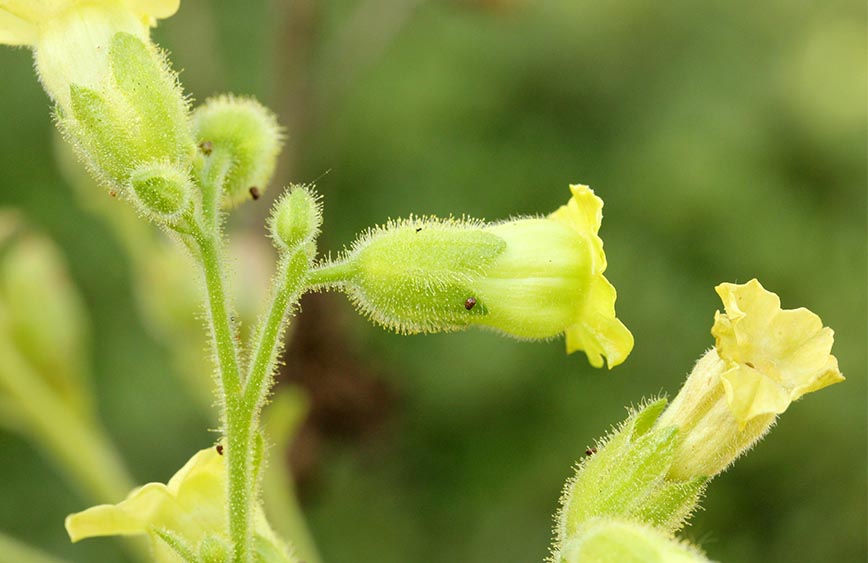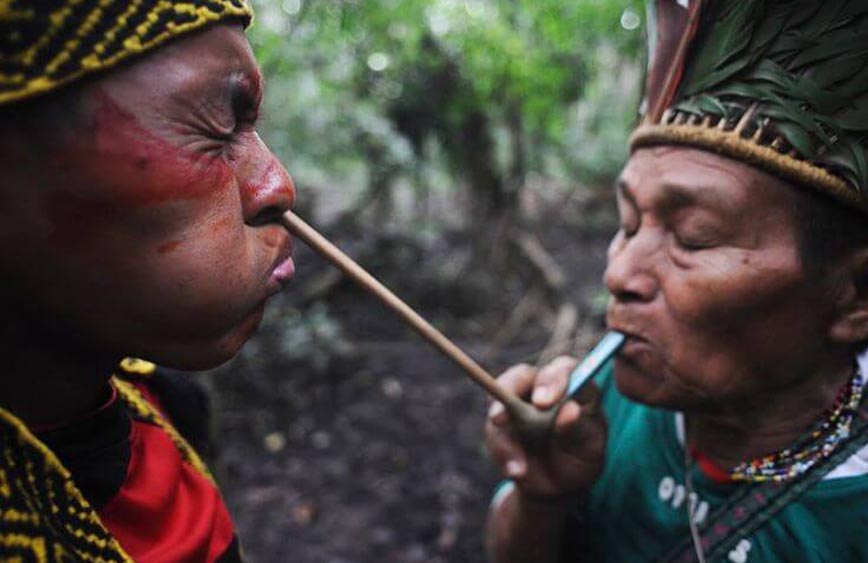Traditional production of Rapé
From the indigenous point of view, Rapé has enormous meaning. It is a sacred shamanic medicine, with profound healing powers.
Making sacred Rapé is a laborious process, and its production is carried out in a ceremonial context, from the collection of sacred plants, to the cooking and processing of the medicine. The person who makes the snuff mixture is a shaman or experienced person, with a deep knowledge of the medicinal plants used and the medicine of snuff.
The different varieties of Rapé are made with specific proportions of Mapacho and sacred ashes, and with different medicinal plants that give each variety its specific properties.
The Mapacho that the Amazonian tribes use to make Rapé is grown by themselves, free of additives, pesticides and chemical fertilizers.
To make Rapé, the Mapacho is transformed by crushing and sifting successively, until obtaining a very fine powder. The person who does this must concentrate in absolute silence, since it is considered that much of the “force” present in the Rapé comes from the intention of the person who crushes the Mapacho.
Next, the Mapacho powder is mixed with ash, for example from pau pereira, tsunu, or others.
Finally, they add the last ingredients to obtain the final mixture; certain specific medicinal plants for each mixture, which have previously been dried in the sun or roasted, and ground and sifted several times.
This sacred Rapé preparation with deep medicinal meaning is a process that can take weeks. Typically, the tribe’s shaman, the Pajé, works under a strict diet and in a trance state as he taps and mixes the snuff herbs incessantly. The other members of the tribe are responsible for collecting plants to prepare Rapé.
Since there are countless medicinal plants that are added to different varieties of Rapé, there are many tribe-specific recipes, and their detailed composition is often a well-protected secret. Some of their snuff blends contain psychoactive plants such as jurema or yopo.
The Katukina, Yawanawa, Kaxinawa, Nukini, Kuntanawa, Apurina, Ashaninka and Matses tribes produce their own specific types of Rapé mixture and have different ways of preparing it, from specific techniques to songs that are sung during rituals when making snuff.


It is even necessary to know precisely what part of each plant can be used and when it must be harvested. For example, the root bark of a plant may have a different purpose and effect than the leaves or seeds of the same plant.
Members of the Amazonian tribes know the energy of plants and their meaning, since they are in permanent contact with nature, often fasting, drinking only water and some master plants.
Added to this self-knowledge and special connection with nature is the transmission of wisdom about master and medicinal plants that has been passed down from generation to generation for thousands of years. When buying Rapé, it is good to make sure that it is a snuff made in an ancestral way by one of these tribes, and retains its ancient meaning.
In previous times, the Pajé would mix the ingredients in an individual ceremony. Today, the entire tribe usually participates in this ceremonial and magical event. Only recently have tribes shared their sacred medicine with foreign friends, passing on the knowledge for generations to come. Still, many compositions remain a secret of each tribe.
Ashes and Rapé
One of the two essential ingredients in Rapé is ash, and probably the most mysterious and unknown. The ash serves as a chemical activator that gives strength to the medicine. It is the fire element added to the earth, it is what gives strength and elevates you. All the shamanic Rapés we know and love use it. Only the green Awiry of Apurinã, the Nunu of the Matses and the powdered Mapacho do not use ashes.
How to burn the bark to obtain a good result requires knowledge and experience. The fire that burns the bark should not burn too hot, but not too soft either.
When Rapé is produced, intention and state of mind are essential, everything that the person thinks, feels and desires when making the medicine, is transferred and stored in that medium. For this reason, it is important that the people who produce medicine do so with clean intentions, a positive attitude, are kind, and have a certain level of spiritual evolution.
In general, people think that ashes are ashes and there is nothing more, but nothing could be further from the truth; First of all, getting a nice white ash and not a gray mess is an art.
When wood is burned, the cellulose combusts and becomes the white ash we see, but most of the salts, alkaloids and other particles survive the fire and remain present in the ash in different proportions. From an alchemical point of view, ashes represent the body of the bark in concentrated form, containing intact the mineral salts of the bark.
On a more subtle and energetic level, ashes, after their transformation and purification process, bring the element of fire to medicine. The Mapacho represents the earth element. Smoking Mapacho has a grounding effect, as does traditional ashless Rapé.
Shamanic Rapé is more stimulating and leads to another level of perception, thanks to the chemical and energetic reactions that occur when adding the ash.


Types of ash
The texture of the wood gives the consistency to the ash, which is why most varieties of wood used for Snuff ashes have a tight grain, and are very hard and dense. Trees with softer wood types do not produce adequate ash; They do not give strength to the medicine, and Snuff spoils more easily. There are some exceptions, such as certain types of vines;It’s a general rule.
The most common ash used for Rapé is Tsunu, the classic ash of the Yawanawá. Other commonly used ashes are Murici, Pau Pereira, Parica, Cacao, Cumaru, Mulateiro and Canela de Velho. Some rarer ones are those of Sapota, Balsamo and Emburana, among others.
Information circulates on the Internet that Tsunu is Pau Pereira, this is not correct and saying which tree is Pau Pereira is complex since in different areas of Brazil different species are called Pau Pereira. Most of the names used to identify these species are local folk names.
Traditionally, Rapé makers burned only the bark of most varieties. Nowadays, with the expansion of Rapé consumption, some manufacturers generally burn the bark together with the wood, to increase yield. Apparently, the bark contains most of the properties, and we can see that teas and other preparations are made from many medicinal trees exclusively from the bark, almost never from the wood, just like the ashes.
Unfortunately, not everyone burns the right wood, there are always unethical people or people without proper knowledge, so it is always good to know the source of your medicine.


Ashes around the world
Many of the sacred indigenous medicines and stimulants used around the world make use of ashes as a chemical activator: The inhabitants of the Andes mountains who chew coca leaves, the Indians (of India) who chew Pan, the betel nut and its blade, the tribes that use the Yopo; They all use the same technique of using their favorite plants in combination with a base activator. It can be in the form of lime taken from crushed shells, baking soda, ashes or other sources.
The ashes used with coca leaves in Bolivia are made from quinoa, bananas and other plants.
In West Africa they make their traditional soap with ashes. Again, they burn a certain mixture of plant materials and mix these ashes with oils to create a reaction that turns the oil into soap. This soap is known to be very good for the skin, and is also used in their religious practices for energy cleansing.
In fact, the transformation of materials through fire is the essence of the ancient art of alchemical transformation; Fire transforms, and has the power to purify everything it touches.
In Ayurvedic medicine there is an extensive science, a form of alchemy related to the manufacture and application of medicinal ashes, the so-called Bhasmas. They produce ashes from a wide variety of substances, plants, minerals, and even certain metals. Each substance burned and transformed by fire has its own properties and its own usefulness. Bhasmas have a special place in Rasayana, the science of rejuvenation. This practice, even in Ayurveda, has almost been lost today.
Just to mention, Ayurveda also has the practice of Nasya, which is the use of medicinal tobacco gently blown into the nasal passages for a variety of ailments.
